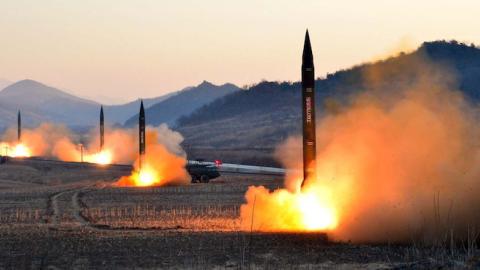A ballistic-missile launch somewhere in Kim Jong Un’s serial ballistic-missile tests are becoming more accurate—and more dangerous. Last Monday three of four intermediate-range ballistic missiles dropped within 200 miles of Japan’s coastline, inside its Exclusive Economic Zone. Last August a submarine-launched ballistic missile traveled more than 300 miles, into Japan’s Air Defense Identification Zone. Even more alarming, last week’s tests were part of a drill by North Korean artillery units whose mission is attacking U.S. bases in Japan.
It’s time to stop talking about how to stop these tests, and time for the Trump administration to take action. That doesn’t mean military action. The answer to the North Korean threat isn’t bombing missile sites or putting boots on the ground, but putting technology in the sky that both the U.S. and Japan could deploy in a very short time—technology that can all but eliminate Pyongyang’s menace.
How serious is the threat? In 2016 Pyongyang staged at least 25 test launches involving seven systems, from intermediate-range missiles capable of reaching targets in Japan and American bases in Guam, to submarine-launched ballistic missiles that can’t be detected until after launch. Most tests have been failures. But practice makes perfect, and if North Korea can arm the kind of intermediate-range missile tested Monday with a nuclear device—it conducted two nuclear tests last year—the world is facing a new, potentially catastrophic era of nuclear danger.
Diplomacy has failed to stop Pyongyang’s missile or nuclear-weapons program. Sanctions have also proved ineffective, while the option for military action is limited and potentially dangerous, given North Korea’s proximity to its patron and protector, China.
That leaves ballistic-missile defense. To its credit, the Obama administration agreed to install land-based and sea-based missile technology like Thaad and Aegis to protect South Korea and Japan. The problem with these systems is that they can shoot down an incoming ballistic missile only toward the end of its flight, as it re-enters the atmosphere. That narrows the margin for error. If the interceptor misses or intercepts a nuclear-armed missile too close to a target like Tokyo or Okinawa, the result could still be catastrophic.
There’s a better alternative. Technology exists now for stopping a North Korean missile launch much earlier, in its boost phase. It’s called boost-phase intercept, or BPI, and the U.S. and Japan have the means to deploy it.
All large multistage rockets require high-thrust booster engines to push them out of the atmosphere, which then drop away when the missile achieves orbit. Destroying a missile at this early boost phase has many advantages. Since it’s the hottest stage of a ballistic-missile launch, it’s the easiest for infrared sensors to detect and identify. It’s also the slowest phase of the launch, so the missile loses any advantage it might have in speed in its later descent.
A BPI would be launched not from a ground- or sea-based system like Thaad or Aegis, but from an unmanned aerial vehicle waiting at 55,000 feet and equipped with infrared sensors that will detect missile launches from 350 miles outside North Korean airspace. Even a submarine-based missile could be detected minutes after launch, something neither Thaad nor Aegis can do currently.
The aerial vehicle would be equipped with a conventional antimissile missile of 225 kilograms, more than enough firepower to bring down even a large intercontinental ballistic missile. Once the launch is detected, operators of the BPI system would have nearly a minute to decide whether a launch is genuine or not, and then to initiate the intercept—more than enough time to prevent a mistake. In addition, a boost-phase intercept is early enough in the missile trajectory that any debris would fall into the sea or North Korea.
There are already American-built unmanned aerial vehicles capable of carrying up to four interceptor missiles of this size, while conventional aircraft have successfully done BPI tests using missiles of this type. Putting those vehicles on a rotating patrol off the North Korean coastline would mean continuous surveillance and detection.
Leonard Caveny, who served as science and technology director for President Reagan’s Ballistic Missile Defense Organization, has estimated that a proof-of-concept launch could be ready in less than two years and cost as little as $25 million.
That seems a small price for a high-tech tool that can protect us from North Korean missile attack. Only regime change in Pyongyang will definitely end the North Korean missile and nuclear threat. Meanwhile, unmanned BPI could allow us all to rest easier—and deprive Kim Jong Un of his chief tool for international blackmail.



















